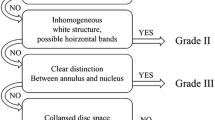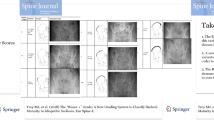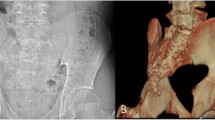Abstract
Resnick-Niwayama criteria for diagnosing DISH depict an advanced stage, and a new reduced cut-off point with three contiguous vertebrae affected (two bone bridges) has been proposed. The aim has been to know the interobserver agreement by using a graded scale of DISH in which grade II matches with the new proposed cut-off point and grade III matches with the first criterion of Resnick-Niwayama. Males ≥ 50 years and postmenopausal women included in a population-based prospective study (the Camargo Cohort) were analyzed. Sample size was obtained according to an expected kappa of 0.95 and an accuracy of ± 8%. Three physicians applied independently Schlapbach graded scale (ranged from grade 0, no ossification, to grade III, ≥ 3 consecutive bone bridges) on the lateral radiographs of thoracic and lumbar spine of participants. We calculated inter- and intra-observer agreement and correlation. One hundred and fifty eight radiographs (79 patients, 68 ± 9 years) were assessed. Kappa values (95% confidence interval) for grades 0, I, II, and III were 0.63 (0.50–0.77), 0.49 (0.37–0.62), 0.32 (0.17–0.47), and 0.69 (0.60–0.77), respectively. Weighted kappa for the three pairs of raters were 0.87 (0.82–0.93), 0.84 (0.77–0.91), and 0.81 (0.72–0.90). Grade III was the image that generated greater agreement, while a significant decrease was noted in grade II, the new proposed criterion. The simultaneous presence of an incomplete DISH and osteoarthritis, in a thoracic spinal segment with peculiar anatomical characteristics (reduced disk spaces, kyphotic curve), is thought to be a major cause of variability in the results.



Similar content being viewed by others
References
Mader R, Sarzi-Puttini P, Atzeni F, Olivieri I, Pappone N, Verlaan JJ, Buskila D (2009) Extraspinal manifestations of diffuse idiopathic skeletal hyperostosis. Rheumatology 48:1478–1481
Forestier J, Rotés-Querol J (1950) Senile ankylosing hyperostosis of the spine. Ann Rheum Dis 9:321–330
Olivieri I, Trippi D, Gherardi S, Pdsero G (1987) Coexistence of ankylosing spondylitis and diffuse idiopathic skeletal hyperostosis: another report. J Rheumatol 14:1058–1060
Resnick D, Niwayama G (1976) Radiographic and pathologic features of spinal involvement in diffuse idiopathic skeletal hyperostosis (DISH). Radiology 119:559–568
Mader R, Verlaan JJ, Buskila D (2013a) Diffuse idiopathic skeletal hyperostosis: clinical features and pathogenic mechanisms. Nat Rev Rheumatol 9:741–750
Kim BS, Moon MS, Yoon M, Kim ST, Kim SJ, Kim MS et al (2018) Prevalence of diffuse idiopathic skeletal hyperostosis diagnosed by whole spine computed tomography: a preliminary study. Clin Orthop Surg 10:41–46
Vaishya R, Vijay V, Nwagbara IC, Agarwal AK (2017) Diffuse idiopathic skeletal hyperostosis (DISH): a common but less known cause of back pain. J Clin Orthop Trauma 8:191–196
Mader R, Verlaan JJ, Eshed I, Jacome BA, Puttini PS, Atzeni F et al (2017) Diffuse idiopathic skeletal hyperostosis (DISH): where we are now and where to go next. RMD Open 3:e000472
Pillai S, Littlejohn G (2014) Metabolic factors in diffuse idiopathic skeletal hyperostosis: a review of clinical data. Open Rheumatol J 8:116–128
Mader R, Novofastovski I, Schwartz N, Rosner E (2018) Serum adiponectin levels in patients with diffuse idiopathic skeletal hyperostosis (DISH). Clin Rheumatol 37:2839–2845
Kuperus JS, de Gendt E, Oner FC, de Jong PA, Buckens S, van der Merwe A et al (2017) Classification criteria for diffuse idiopathic skeletal hyperostosis: a lack of consensus. Rheumatology 56:1123–1134
Kuperus JS, Buckens CF, Šprem J, Oner FC, de Jong PA, Verlaan JJ (2018) The natural course of diffuse idiopathic skeletal hyperostosis in the thoracic spine of adult males. J Rheumatol 45:1116–1123
Mader R, Buskila D, Verlaan JJ, Atzeni F, Olivieri I, Pappone N, di Girolamo C, Sarzi-Puttini P (2013b) Developing new classification criteria for diffuse idiopathic skeletal hyperostosis: back to square one. Rheumatology 52:326–330
Mata S, Chhem RK, Fortin PR, Joseph L, Esdaile JM (1998) Comprehensive radiographic evaluation of diffuse idiopathic skeletal hyperostosis: development and interrater reliability of a scoring system. Semin Arthritis Rheum 28:88–96
Hernández JL, Olmos JM, Pariente E, Martínez J, Valero C, García-Velasco P, Nan D, Llorca J, González-Macías J (2010) Metabolic syndrome and bone metabolism: the Camargo cohort study. Menopause 17:955–961
Schlapbach P, Beyeler C, Gerber NJ, Van der Linden SJ, Bürgi U, Fuchs WA et al (1989) Diffuse idiopathic skeletal hyperostosis (DISH) of the spine: a cause of back pain? A controlled study. Br J Rheumatol 28:299–303
Beyeler C, Thomann SR, Gerber NJ, Kunze C, Aeberli D (2015) Diffuse idiopathic skeletal hyperostosis (DISH) of the elbow: a controlled radiological study. BMC Musculoskelet Disord 16:119
Utsinger PD (1985) Diffuse idiopathic skeletal hyperostosis. Clin Rheum Dis 11:325–351
Julkunen H, Heinonen OP, Pyörälä K (1971) Hyperostosis of the spine in an adult population – Its relation to hyperglycaemia and obesity. Ann Rheum Dis 30:605–612
Sim J, Wright C (2005) The kappa statistic in reliability studies: use, interpretation and sample size requirements. Phys Ther 85:257–268
Bruton A, Conway JH, Holgate ST (2000) Reliability: what is it, and how is it measured? Physiotherapy 86:94–99
Blasingame JP, Resnick D, Coutts RD, Danzig LA (1981) Extensive spinal osteophytosis as a risk factor for heterotopic bone formation after total hip arthroplasty. Clin Orthop 161:191–197
Bloom RA (1984) The prevalence of ankylosing hyperostosis in a Jerusalem population - with description of a method of grading the extent of the disease. Scand J Rheumatol 13:181–189
Fornasier VL, Littlejohn G, Urowitz MB (1983) Spinal entheseal new bone formation: the early changes of spinal diffuse idiopathic skeletal hyperostosis. J Rheumatol 10:939–947
Haller J, Resnick D, Miller CW, Schils JP, Kerr R, Bielecki D, Sartoris DJ, Gundry CR (1989) Diffuse idiopathic skeletal hyperostosis: diagnostic significance of radiographic abnormalities of the pelvis. Radiology 172:835–839
Otsuki B, Fujibayashi S, Takemoto M, Kimura H, Shimizu T, Matsuda S (2015) Diffuse idiopathic skeletal hyperostosis (DISH) is a risk factor for further surgery in short-segment lumbar interbody fusion. Eur Spine J 24:2514–2519
Holton KF, Denard PJ, Yoo JU, Kado DM, Barrett-Connor E, Marshall LM, Osteoporotic Fractures in Men (MrOS) Study Group (2011) Diffuse idiopathic skeletal hyperostosis (DISH) and its relation to back pain among older men: the MrOS study. Semin Arthritis Rheum 41:131–138
Pariente E, Olmos JM, Landeras R, Nan D, González-Macías J, Hernández JL (2017) Relationship between spinal osteoarthritis and vertebral fractures in men older than 50 years: data from the Camargo cohort study. J Bone Miner Metab 35:114–121
Oudkerk SF, de Jong PA, Attrach M, Luijkx T, Buckens CF, Mali WP et al (2017) Diagnosis of diffuse idiopathic skeletal hyperostosis with chest computed tomography: inter-observer agreement. Eur Radiol 27:188–194
Slonimsky E, Lidar M, Stern M, Eshed I (2018) Degenerative changes of the thoracic spine do exist in patients with diffuse idiopathic skeletal hyperostosis: a detailed thoracic spine CT analysis. Acta Radiol 59:1343–1350
Hirasawa A, Wakao N, Kamiya M, Takeuchi M, Kawanami K, Murotani K, Matsuo T, Deie M (2016) The prevalence of diffuse idiopathic skeletal hyperostosis in Japan The first report of measurement by CT and review of the literature. J Orthop Sci 21:287–290
Verlaan JJ, Westerveld LA, van Keulen JW, Bleys RL, Dhert WJ, van Herwaarden JA et al (2011) Quantitative analysis of the anterolateral ossification mass in diffuse idiopathic skeletal hyperostosis of the thoracic spine. Eur Spine J 20:1474–1479
Sade R, Ulusoy OL, Sirvanci M, Bayraktutan U, Kantarci M (2016) Cord compression and myelopathy due to stress fracture in a patient with diffuse idiopathic skeletal hyperostosis (DISH). Spine J 16:e503–e504
Funding
The study has been funded in part by the Health Institute Carlos III (PI15/00521), Ministerio de Economía y Competitividad, Spain, which includes FEDER funds from the European Union.
Author information
Authors and Affiliations
Corresponding author
Ethics declarations
Disclosures
None.
Additional information
Publisher’s Note
Springer Nature remains neutral with regard to jurisdictional claims in published maps and institutional affiliations.
Rights and permissions
About this article
Cite this article
Pini, S.F., Acosta-Ramón, V., Tobalina-Segura, M. et al. Interobserver agreement using Schlapbach graded scale for diffuse idiopathic skeletal hyperostosis (DISH): can we reduce the cut-off point of vertebral affection?. Clin Rheumatol 38, 1155–1162 (2019). https://doi.org/10.1007/s10067-018-4398-2
Received:
Revised:
Accepted:
Published:
Issue Date:
DOI: https://doi.org/10.1007/s10067-018-4398-2




